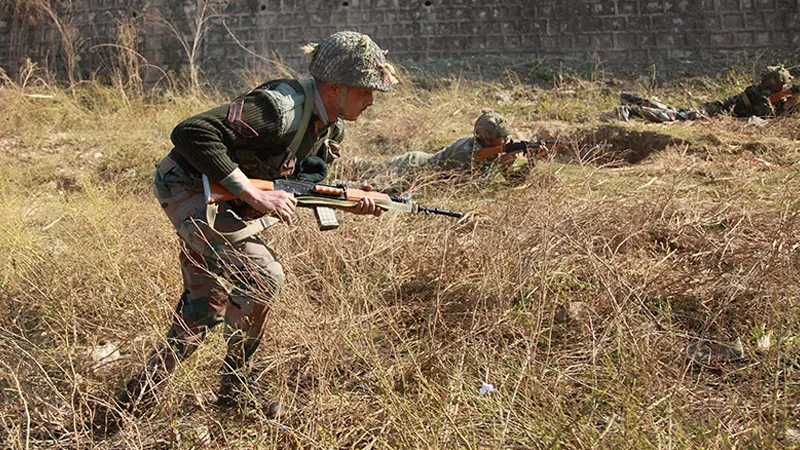-
CENTRES
Progammes & Centres
Location

In all honesty, the Indian Army has gone through a very patchy period this past month. Despite statements to the contrary by the Chief of Army Staff, the Pathankot operation was an unmitigated disaster. Undoubtedly the terrorists’ designs were foiled and all of them neutralised, but the cost was disproportionately high and probably avoidable. Analysts believe incorrect force utilisation and tasking along with faulty command and control structures and poor coordination was responsible for what followed.
There are unconfirmed reports that Lieutenant Colonel Niranjan Kumar, the Bomb Disposal specialist who was killed while defusing a grenade, may have been under pressure from his superiors to hasten up clearance operations. A similar allegation has also been made that the Special Forces elements, conducting the intervention operations at Pampore, of which two officers and a non-commissioned officer were killed, were also forced to speed up operations due to orders from above. If there is even a modicum of truth in these allegations, it reflects poorly on the professionalism of the chain of command and points towards a inexperienced and deeply flawed leadership.
The Pampore operation was unique in many ways. The building selected by the terrorists, an isolated four-storied concrete structure with a sloping tin roof ending in an overhang, as is common in Kashmir, was ideal for what they had planned. It gave them the advantage of height, which allowed them tactical domination and good fields of fire, while the structure offered a fair amount of protection against small arms fire, high explosive grenades and rockets. The sloping roof also ensured troops could not be dropped on the roof from where they could have then abseiled down to the lower floors and made multiple entries.
However, the terrorists lost the initiative once they had ambushed the Central Reserve Police Force convoy and then withdrawn and occupied the building, especially after it was cordoned off,closing all avenues of escape which could only lead to capture or death. The advantage of having pinned them in one location, though not of our choosing, was further amplified by the fact that they had not taken hostages and were in an isolated building, thereby greatly reducing, if not completely nullifying any chances of collateral damage and civilian casualties. It was then only a matter of time before these terrorists were neutralised by carrying out a stand-off fire assault. This has been the usual practice for decades, and building interventions were only carried out if hostages had been taken and there was a likelihood of them being killed, or if it was envisaged that the terrorists may be able to break contact and escape under the cover of darkness.
Even if there were some valid reasons for senior commanders to hasten operations or lay down time restrictions as alleged — though this writer cannot think of any — there were still different options available for neutralising the terrorists without resorting to an assault through the front door and incurring unnecessary casualties. The easiest and most cost-effective option would have been to approach the building in an attack helicopter and destroy the floor on which the terrorists had deployed.
The Armed Forces have rightly desisted from using the Air Force to carry out air raids while engaged in counter-insurgency operation, ever since it was used for the first and only time in 1966 during the Mizo uprising, as the principle of minimum force must be applied when dealing with our own population, even if they are disaffected and have taken up arms against the state.
However, in this case the circumstances were different and the use of helicopters would have been fully justified, as they would have been directed against non-state foreign terrorists engaged in pin-point attacks with no collateral damage to our citizens. Such tactics would have sent a strong message to the leadership of terror organisations involved as well as their sponsors within the Pakistan establishment.
Unfortunately, the Armed Forces senior leaders has always been excessively timid, conservative and unwilling to change, especially if tactics in vogue have worked well earlier. They are unquestioning of their political masters and tend to voluntarily lay down self-imposed restrictions on the manner in which operations are conducted.
Kargil is the perfect example of this mindset. Former Prime Minister Atal Bihari Vajpayee gave directions that the Line of Control would not be crossed and the military leadership refused to either question his reasoning or request any modifications. The result was, and as has been the case at Pampore, that assaults were launched along expected approaches resulting in excessive and completely avoidable casualties. While Mr Vajpayee may have gained plaudits from the international community, one can seriously question if his policy gave us any real dividends?
We are still under attack by the Pakistani elements and the US continues to only pay lip service while providing billions of dollars of weapons and other aid to Pakistan. The military brass must carry out introspect and stands up for the men under its command. Our soldiers are not cannon fodder. As somebody has suggested, paying homage to martyrs is not what the brass gets paid for. Senior commanders must remember what General George S Patton said: “No b#####d ever won a war by dying for his country. He won it by making the other poor dumb b#####d die for his country.”
This commentary originally appeared in The Pioneer.
The views expressed above belong to the author(s). ORF research and analyses now available on Telegram! Click here to access our curated content — blogs, longforms and interviews.

Brig. Deepak Sinha (Retd.) was Visiting Fellow at ORF. Brig. Sinha is a second-generation paratrooper. During his service, he held varied command, staff and instructional appointments, ...
Read More +